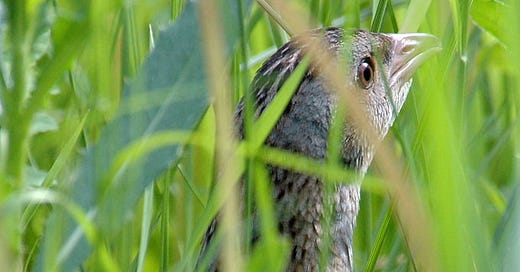The call rang out loud, clear and persistent, Crex! Crex! …Crex! Crex! ...Crex! Crex! The wanderer had returned. The scientific binomial name for the Corncrake [Crex crex] is a perfect onomatopoeic word which phonetically resembles or suggests the sound that the bird makes.

It is a bird which you will rarely see but if you are in the correct habitat [usually wet meadows] at the right time of year and of an evening you just cannot mistake the call, it rings out above anything else and it is a constant leitmotif of the night. If this one I heard was any closer to the house I think that we would not get much sleep at night. My wife would be shoving the cat out of the window and telling it to fetch! [not really].
We are fortunate to have them here [near Durness] and I look forward to their return every year, I welcome the feelings and emotions the call gives rise to, similar associations to that of the curlew and the loons calling, carrying the atmosphere of the highlands and islands in an eerie transmutable sound, a sound which is more of a feeling, an emotion indeed.
Whist here, they are rarely seen flying. Perhaps this is no surprise since they have come all the way from Africa and maybe had enough of flying. Once widespread across the country they are now rare and threatened. Our changing land practises were not friendly to corncrakes, possibly wiping them out with much earlier harvesting of crops with machinery. All is not lost, not yet anyway, the outer isles still have a healthy population and they have been re-introduced to areas of England, so there is hope.

I have a game for children in which I try to teach them some bird calls. First, I will imitate the call, [I’m good at a few but not many], then if they don’t know I show a picture of the bird and make the call, then I tell them and we all have to try to imitate the call at the same time, it can be a loud raucous game!
All recognise the cuckoo, none recognise the corncrake, the favourite is usually my owl hoot or the yellow hammer with its “little bit of bread and no cheese” song.
The same day I heard the crake - I also heard our first Durness cuckoo [Cuculus canorus] of the year. It is another bird with name which obviously sounds like the call. I’d seen a cuckoo weeks earlier but heard no call, a gamekeeper friend told me many years ago that from his observations the males arrived well before the females but did not start calling until the partners appeared, giving them something to sing about. I don’t know how accurate that information is.

Not so many people recognise [or realise] the female also calls, but hers is more of a peculiar bubbling babbling gurgling sound. My father used to call them Gowks, it was a common Scottish term for them, strangely it is also a Scottish term for a fool [possibly of Norse origin].
As we enjoy the many interesting calls and appearances of such distinctive birds as the Corncrake during their fleeting visits, it's important to reflect on the conservation status of this elusive bird. Classified as a Schedule 1 bird under the Wildlife and Countryside Act, the Corncrake is also listed as a species of conservation concern on the Red List.
These unique calls - resonating across the highlands and islands are not just the calls of the wild—but calls to preserve the wild, ensuring that future generations may also experience the thrill of hearing the Corncrake's call echo through the night. Let us listen, act, and hope that with concerted effort, the Corncrake will continue to return each year, a true symbol of resilience and the beauty of our natural world.
Donald Mitchell is a High Life Highland Countryside Ranger, a keen observer of nature and wildlife, he dedicates his time to documenting and sharing insights about the natural habitats in North West Sutherland. With a particular interest in marine life, he aims to help others gain a deeper understanding and respect for the delicate balance of our ecosystem.
Echoes of a Gaelic Spring: The Cuckoo's Call and Conservation
Today, I heard my first cuckoo of 2024 and immediately my mind went to the same Gaelic words that it does every year: O fàilte ort fhèin, a chuthag ghorm, Led òran ceòlmhor milis! 'S e seirm do bheòil sa Chèitein òig A thogadh bròn o m' chridhe 'S ro-bhinn leam t'fhuaim 's a' mhaduinn chéit',





